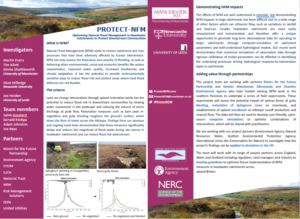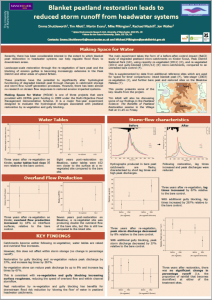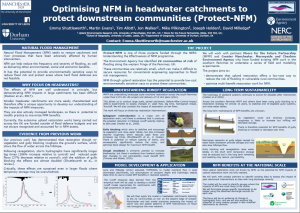Protect-NFM: Optimising NFM in headwater catchments to protect downstream communities
Investigators: Martin Evans (lead), Tim Allott, Emma Shuttleworth (University of Manchester); Dave Milledge, Salim Goudarzi (Newcastle University); Joe Holden (University of Leeds).
Focus on: Peak District, upland catchments with blanket peat cover.
Click on the image below to download a summary of Protect-NFM’s work.
NFM measures: Moorland restoration, including gully blocking, Sphagnum reintroduction and upland woodland planting
The project aims to demonstrate that upland moorland restoration offers a low-cost way to reduce the risk of flooding in vulnerable rural communities, and to optimise multi-benefit restoration work for NFM.
Headwaters comprise 60-80% of the length of most river systems, and their steep slopes and high rainfall volumes mean that they are important areas of hillslope runoff production. The Environment Agency has identified 22 communities at risk of flooding along the western fringe of the Pennines. These communities are relatively small, which can make it difficult to secure resources for conventional engineering approaches to flood risk management.
The Protect-NFM team is working closely with project partners Moors for the Future Partnership and the Environment Agency to assess the impact of various forms of moorland restoration (gully blocking, Sphagnum reintroduction, and establishment of upland woodlands) on hillslope runoff production and channel flow. They are also investigating the longer term evolution of restoration measures to better understand the longevity of NFM benefits.
To facilitate planning and prediction of potential impacts, Protect-NFM is developing conceptually sophisticated but user-friendly, open-source models to optimise combinations of interventions. Later in the project, they will work with project partners (Environment Agency, Natural Resources Wales, Scottish Environmental Protection Agency, International Union the Conservation for Nature) to investigate how the project’s findings can be applied to elsewhere in the UK.
Click on the images below to access posters describing the Protect-NFM project.
You can see a short film about Protect-NFM’s work here.
For more, see the Protect-NFM website.





